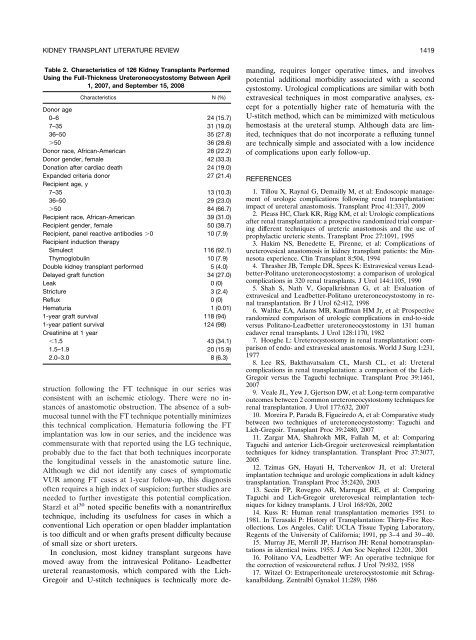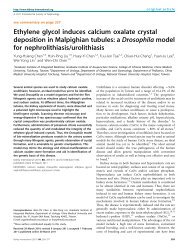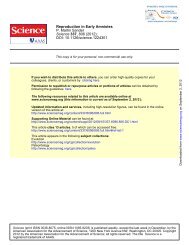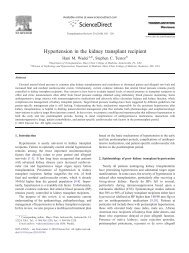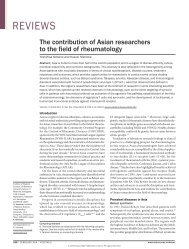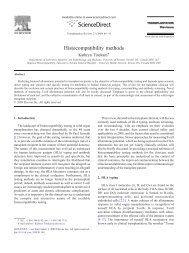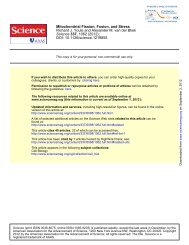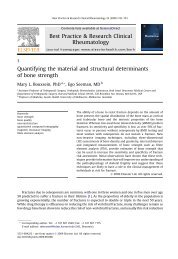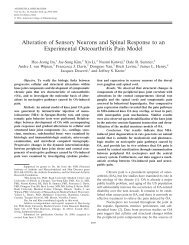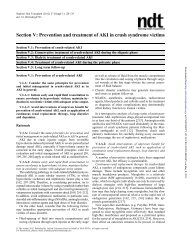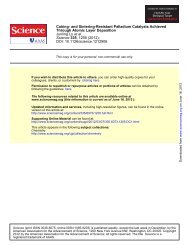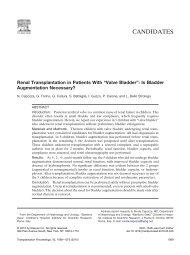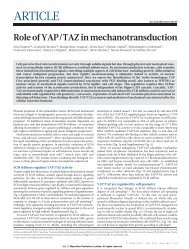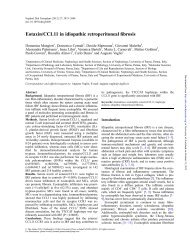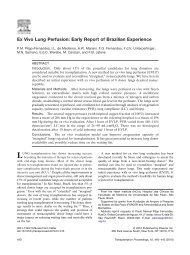Kidney Transplant Ureteroneocystostomy Techniques and ...
Kidney Transplant Ureteroneocystostomy Techniques and ...
Kidney Transplant Ureteroneocystostomy Techniques and ...
Create successful ePaper yourself
Turn your PDF publications into a flip-book with our unique Google optimized e-Paper software.
KIDNEY TRANSPLANT LITERATURE REVIEW 1419<br />
Table 2. Characteristics of 126 <strong>Kidney</strong> <strong>Transplant</strong>s Performed<br />
Using the Full-Thickness <strong>Ureteroneocystostomy</strong> Between April<br />
1, 2007, <strong>and</strong> September 15, 2008<br />
Characteristics N (%)<br />
Donor age<br />
0–6 24 (15.7)<br />
7–35 31 (19.0)<br />
36–50 35 (27.8)<br />
50 36 (28.6)<br />
Donor race, African-American 28 (22.2)<br />
Donor gender, female 42 (33.3)<br />
Donation after cardiac death 24 (19.0)<br />
Exp<strong>and</strong>ed criteria donor 27 (21.4)<br />
Recipient age, y<br />
7–35 13 (10.3)<br />
36–50 29 (23.0)<br />
50 84 (66.7)<br />
Recipient race, African-American 39 (31.0)<br />
Recipient gender, female 50 (39.7)<br />
Recipient, panel reactive antibodies 0 10 (7.9)<br />
Recipient induction therapy<br />
Simulect 116 (92.1)<br />
Thymoglobulin 10 (7.9)<br />
Double kidney transplant performed 5 (4.0)<br />
Delayed graft function 34 (27.0)<br />
Leak 0 (0)<br />
Stricture 3 (2.4)<br />
Reflux 0 (0)<br />
Hematuria 1 (0.01)<br />
1-year graft survival 118 (94)<br />
1-year patient survival 124 (98)<br />
Creatinine at 1 year<br />
1.5 43 (34.1)<br />
1.5–1.9 20 (15.9)<br />
2.0–3.0 8 (6.3)<br />
struction following the FT technique in our series was<br />
consistent with an ischemic etiology. There were no instances<br />
of anastomotic obstruction. The absence of a submucosal<br />
tunnel with the FT technique potentially minimizes<br />
this technical complication. Hematuria following the FT<br />
implantation was low in our series, <strong>and</strong> the incidence was<br />
commensurate with that reported using the LG technique,<br />
probably due to the fact that both techniques incorporate<br />
the longitudinal vessels in the anastomotic suture line.<br />
Although we did not identify any cases of symptomatic<br />
VUR among FT cases at 1-year follow-up, this diagnosis<br />
often requires a high index of suspicion; further studies are<br />
needed to further investigate this potential complication.<br />
Starzl et al 30 noted specific benefits with a nonantrireflux<br />
technique, including its usefulness for cases in which a<br />
conventional Lich operation or open bladder implantation<br />
is too difficult <strong>and</strong> or when grafts present difficulty because<br />
of small size or short ureters.<br />
In conclusion, most kidney transplant surgeons have<br />
moved away from the intravesical Politano- Leadbetter<br />
ureteral reanastomosis, which compared with the Lich-<br />
Gregoir <strong>and</strong> U-stitch techniques is technically more de-<br />
m<strong>and</strong>ing, requires longer operative times, <strong>and</strong> involves<br />
potential additional morbidity associated with a second<br />
cystostomy. Urological complications are similar with both<br />
extravesical techniques in most comparative analyses, except<br />
for a potentially higher rate of hematuria with the<br />
U-stitch method, which can be mimimized with meticulous<br />
hemostasis at the ureteral stump. Although data are limited,<br />
techniques that do not incorporate a refluxing tunnel<br />
are technically simple <strong>and</strong> associated with a low incidence<br />
of complications upon early follow-up.<br />
REFERENCES<br />
1. Tillou X, Raynal G, Demailly M, et al: Endoscopic management<br />
of urologic complications following renal transplantation:<br />
impact of ureteral anastomosis. <strong>Transplant</strong> Proc 41:3317, 2009<br />
2. Pleass HC, Clark KR, Rigg KM, et al: Urologic complications<br />
after renal transplantation: a prospective r<strong>and</strong>omized trial comparing<br />
different techniques of ureteric anastomosis <strong>and</strong> the use of<br />
prophylactic ureteric stents. <strong>Transplant</strong> Proc 27:1091, 1995<br />
3. Hakim NS, Benedette E, Pirenne, et al: Complications of<br />
ureterovesical anastomosis in kidney transplant patients: the Minnesota<br />
experience. Clin <strong>Transplant</strong> 8:504, 1994<br />
4. Thrasher JB, Temple DR, Spees K: Extravesical versus Leadbetter-Politano<br />
ureteroneocystostomy: a comparison of urological<br />
complications in 320 renal transplants. J Urol 144:1105, 1990<br />
5. Shah S, Nath V, Gopalkrishnan G, et al: Evaluation of<br />
extravesical <strong>and</strong> Leadbetter-Politano ureteroneocystostomy in renal<br />
transplantation. Br J Urol 62:412, 1998<br />
6. Waltke EA, Adams MB, Kauffman HM Jr, et al: Prospective<br />
r<strong>and</strong>omized comparison of urologic complications in end-to-side<br />
versus Politano-Leadbetter ureteroneocystostomy in 131 human<br />
cadaver renal transplants. J Urol 128:1170, 1982<br />
7. Hooghe L: Ureterocystostomy in renal transplantation: comparison<br />
of endo- <strong>and</strong> extravesical anastomosis. World J Surg 1:231,<br />
1977<br />
8. Lee RS, Bakthavatsalam CL, Marsh CL, et al: Ureteral<br />
complications in renal transplantation: a comparison of the Lich-<br />
Gregoir versus the Taguchi technique. <strong>Transplant</strong> Proc 39:1461,<br />
2007<br />
9. Veale JL, Yew J, Gjertson DW, et al: Long-term comparative<br />
outcomes between 2 common ureteroneocystostomy techniques for<br />
renal transplantation. J Urol 177:632, 2007<br />
10. Moreira P, Parada B, Figueiredo A, et al: Comparative study<br />
between two techniques of ureteroneocystostomy: Taguchi <strong>and</strong><br />
Lich-Gregoir. <strong>Transplant</strong> Proc 39:2480, 2007<br />
11. Zargar MA, Shahrokh MR, Fallah M, et al: Comparing<br />
Taguchi <strong>and</strong> anterior Lich-Gregoir ureterovesical reimplantation<br />
techniques for kidney transplantation. <strong>Transplant</strong> Proc 37:3077,<br />
2005<br />
12. Tzimas GN, Hayati H, Tchervenkov JI, et al: Ureteral<br />
implantation technique <strong>and</strong> urologic complications in adult kidney<br />
transplantation. <strong>Transplant</strong> Proc 35:2420, 2003<br />
13. Secin FP, Rovegno AR, Marrugat RE, et al: Comparing<br />
Taguchi <strong>and</strong> Lich-Gregoir ureterovesical reimplantation techniques<br />
for kidney transplants. J Urol 168:926, 2002<br />
14. Kuss R: Human renal transplantation memories 1951 to<br />
1981. In Terasaki P: History of <strong>Transplant</strong>ation: Thirty-Five Recollections.<br />
Los Angeles, Calif: UCLA Tissue Typing Laboratory,<br />
Regents of the University of California; 1991, pp 3–4 <strong>and</strong> 39–40.<br />
15. Murray JE, Merrill JP, Harrison JH: Renal homotransplantations<br />
in identical twins. 1955. J Am Soc Nephrol 12:201, 2001<br />
16. Politano VA, Leadbetter WF: An operative technique for<br />
the correction of vesicoureteral reflux. J Urol 79:932, 1958<br />
17. Witzel O: Extraperitoneale ureterocystostomie mit Schragkanalbildung.<br />
Zentralbl Gynakol 11:289, 1986


